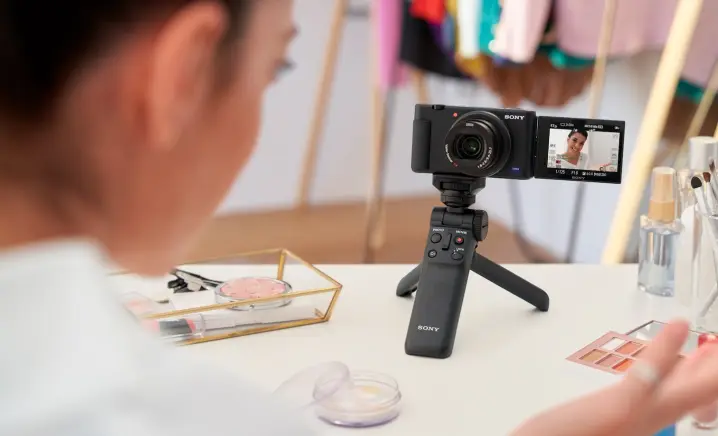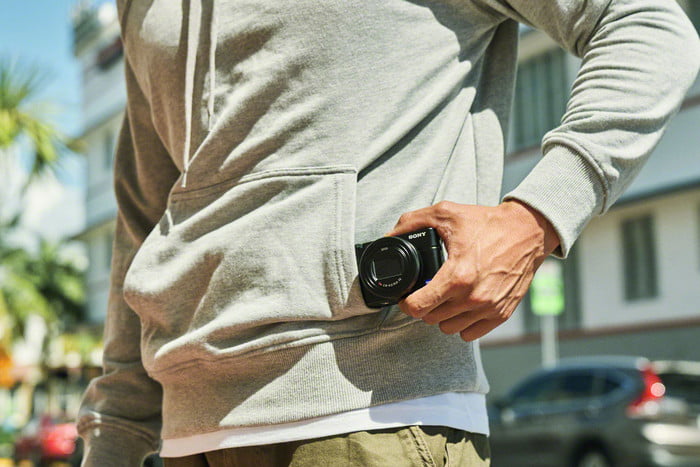In 2019, Digital Trends rated the Sony RX100 VII the best compact camera. Traditionally, Sony releases an updated RX100 model every 12 months — but an RX100 VIII is not what we got this year. Instead, Sony gave us the ZV-1, a camera that is very much like an RX100, but built specifically for vloggers and influencers.
Purists may not warm to the idea of a camera straying away from “real” photography and video production to appeal to this type of creator. But today, the game has changed. YouTube, with over 2 billion viewers, is the most popular video provider in the world. Sony’s cameras were already favorites among YouTubers, and the ZV-1 further narrows in on this niche.
Both cameras have specs that will appeal to photographers and videographers — in fact, they are more similar than they are different. But the ZV-1 certainly shows that video is its priority. That doesn’t mean either camera is only suited to one discipline. Both meet the needs of still photographers and videographers. Which is the right camera for you is more about how you want to use it, rather than what it can do.
At a glance:
Sony RX100 VII
- 20MP 1-inch BSI-CMOS Sensor
- 24-200 mm f2.8-4.5 zoom lens
- UHD 4K/30p
- 2.36 million-dot EVF
- 20 fps continuous shooting
- ISO 125 – 12800
Sony ZV-1
- 20MP 1-inch BSI-CMOS Sensor
- 24-70 mm f1.8-2.8 zoom lens
- UHD 4K/30p
- 24 fps continuous shooting
- ISO 125 – 12800
Video

Let’s tackle the most significant talking point first — video.
From specs alone, it’s clear that the RX100 VII and the ZV-1 provide the same performance. However, while they both arrive at the same destination, their routes are different.
The ZV-1 targets a particular type of creator, those who love to make videos but don’t want the hassle of a more complex system. Easy-to-use settings like Background Defocus, Product Showcase, and Face Priority Autoexposure (features missing from the RX100 VII) allow for more control over creativity, without having to be an expert in f-stops and autofocus modes.
Essentially, the ZV-1 is for those who want a high-quality video camera that works straight out of the box, without spending hours figuring out how to use it. But for those who do know their way around a camera, full manual controls are present.
Both cameras shoot 4K/30p and offer slow-motion frame rates up to 960 frames per second at reduced resolutions. Sony’s Optical Steady Shot and digital stabilization are available in 4K, helping to reduce camera shake when not using a tripod.
For the more experienced videographer, features like Hybrid Log-Gamma (HLG) and S-Log profiles are present in both cameras, as are super slow motion and intervalometer (time-lapse) modes.
Both cameras also feature external microphone inputs, although neither offers a headphone jack. The ZV-1 has the better built-in microphone, which uses three capsules for improved audio quality. Again, for users after a simple out-of-the-box solution who don’t want to plug in an external microphone, the ZV-1 makes sense — but an external mic will likely still provide the best audio quality.
Sensor and lens
Both cameras have the same 20MP 1-inch-type sensor that uses Sony’s latest “stacked” design for improved speed. It’s the best image quality you’ll find on a camera this size. However, while large for a point-and-shoot, a 1-inch sensor still pales in comparison to most mirrorless cameras and DSLRs when it comes to low light sensitivity.

This is where the ZV-1 has a real image quality advantage. Because it uses the shorter 24-70mm (full-frame equivalent) lens, it benefits from a brighter f/1.8-2.8 aperture. The RX100 boasts much more zoom — 24-200mm — but at the cost of over a stop of light at both the wide and telephoto ends. That means the ZV-1 can let in a little more than twice as much light as the RX100, which will help indoors or in other low-light settings.
That wider aperture also makes it possible to achieve a shallower depth of field, blurring out the background to help focus on the subject. While you can also achieve a shallow depth of field simply by zooming all the way to 200mm on the RX100 VII, that isn’t really an option for vloggers — they will be working at or near the wide-angle end of the zoom range.
The RX100 VII’s lens is perfect for travel photography, where you may need the extra reach and are likely outdoors in decent light. Its f/2.8-4.5 aperture is fine in these situations, but you may find it lacking once you come inside.
Design
Both cameras are obviously related, but there are some key design differences and certain features lacking in one that are available in the other.

The biggest talking point is the viewfinder. The RX100 VII comes with a 2.36 million-dot pop-up electronic viewfinder. The ZV-1 is completely void of a viewfinder, leaving the 3-inch articulating LCD screen as the sole way to frame your shots. For photographers, the viewfinder is a big deal, especially in bright light when the LCD may be washed out.
As for the LCDs, both can flip 180 degrees into selfie position. The RX100 VII’s flips up over the top of the camera, while the ZV-1’s flips out to the side, which keeps it in the clear if you have a microphone or light attached to the top of the camera.
You’ll find that won’t matter much on the RX100 VII, though, since there’s not a built-in mounting point on top of the camera. The ZV-1 is the only one with a hot shoe, which can be used to attach a video light, flash, or microphone. The RX100 VII requires a grip accessory to attach any of these things, and isn’t compatible with external flashes at all. It does have a small pop-up flash, however, something the ZV-1 lacks.
Size and weight are important factors when choosing a camera, but you won’t find much of a difference between these two. The RX100 VII comes in heavier at 10.7 ounces, while the ZV-1 is only fractionally lighter at 10.4 ounces. Both can fit in a pocket when turned off.
Which should you buy?
Because both systems excel at what they do, but merely do it in different ways, it’s unfair to say which is overall the better camera. That doesn’t mean one isn’t the better choice for you.
If you’re a new or experienced vlogger who doesn’t want to get lost in complex features and photography, the ZV-1 is the way to go. It’s easy to use but doesn’t sacrifice any of the manual control. It’s also $350 cheaper than the RX100 VII and offers the same video performance and quality.
If you veer more toward photography, need more reach from your lens, and still want a high-performing video camera, then the RX100 VII is the way to go if you can afford it. However, the ZV-1 does have a couple of advantages here, as well. It’s better in low light and offers external flash compatibility.
Editors' Recommendations
- The best point-and-shoot cameras
- Sony has 6 different RX100 cameras. Which one should you buy?
- With the RX100 VII, Sony took the best point-and-shoot and made it better



